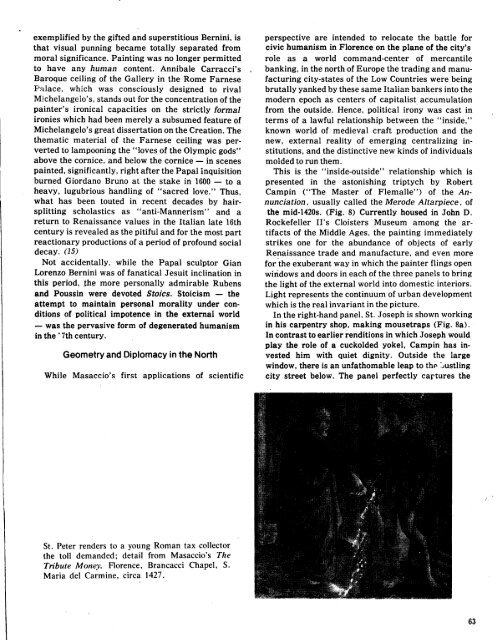Renaissance and
Renaissance and
Renaissance and
Create successful ePaper yourself
Turn your PDF publications into a flip-book with our unique Google optimized e-Paper software.
exemplified by the gifted <strong>and</strong> superstitious Bernini, is perspective are intended to relocate the battle for<br />
that visual punning became totally separated from civic humanism in Florence on the plane of the city's<br />
moral significance. Painting wasnolongerpermitted role as a world comm<strong>and</strong>-center of mercantile<br />
to have any human content. Annibale Carracci's , banking, in the north of Europe the trading <strong>and</strong> manu-<br />
Baroque ceiling of the Gallery in the Rome Farnese facturing city-states of the Low Countries were being<br />
Palace, which was consciously designed to rival brutally yanked by these same Italian bankers into the<br />
Michelangelo's, st<strong>and</strong>s out for the concentration of the modern epoch as centers of capitalist accumulation<br />
painter's ironical capacities on the strictly formal from the outside. Hence, political irony was cast in<br />
ironies which had been merely a subsumed feature of terms of a lawful relationship between the "inside,"<br />
Michelangelo's great dissertation on the Creation. The known world of medieval craft production <strong>and</strong> the<br />
thematic material of the Farnese ceiling was per- new, external reality of emerging centralizing inverted<br />
to lampooning the "loves of the Olympic gods" stitutions, <strong>and</strong> the distinctive new kinds of individuals<br />
above the cornice, <strong>and</strong> below the cornice -- in scenes molded to run them.<br />
painted, significantly, right after the Papal inquisition This is the "inside-outside" relationship which is<br />
burned Giordano Bruno at the stake in 1600 -- to a presented in the astonishing triptych by Robert<br />
heavy, lugubrious h<strong>and</strong>ling of "sacred love." Thus, Campin ("The Master of Flemalle") of the Anwhat<br />
has been touted in recent decades by hair- nunciation, usually called the Merode Altarpiece, of<br />
splitting scholastics as "anti-Mannerism" <strong>and</strong> a the mid-1420s. (Fig. 8) Currently housed in John D.<br />
return to <strong>Renaissance</strong> values in the Italian late 16th Rockefeller II's Cloisters Museum among the ar-<br />
Century is revealed as the pitiful <strong>and</strong> for the most part tifacts of the Middle Ages, the painting immediately<br />
reactionary productions of a period of profound social strikes one for the abundance of objects of early<br />
decay. (15) <strong>Renaissance</strong> trade <strong>and</strong> manufacture, <strong>and</strong> even more<br />
Not accidentally, while the Papal sculptor Gian for_the exuberant way in which the painter flings open<br />
Lorenzo Bernini was of fanatical Jesuit inclination in wiridows <strong>and</strong> doors in each of the three panels to bring<br />
this period, the more personally admirable Rubens the light of the external world into domestic interiors.<br />
<strong>and</strong> Poussin were devoted Stoics. Stoicism -- the Light represents the continuum of urban development<br />
attempt to maintain personal morality under con- which is the real invariant in the picture.<br />
ditions of political impotence in the external world In the right-h<strong>and</strong> panel, St. Joseph is shown working<br />
-- was the pervasive form of degenerated humanism in his carpentry shop, making mousetraps (Fig. 8a).<br />
in the •7th century. In contrast to earlier renditions in which Joseph would<br />
play the role of a cuckolded yokel, Campin has in-<br />
Geometry <strong>and</strong> Diplomacy intheNorth vested him with quiet dignity. Outside the large<br />
window, there is an unfathomable leap to the bustling<br />
While Masaccio's first applications of scientific city street below. The panel perfectly cartures the<br />
St. Peter renders to a young Roman tax collector<br />
the toll dem<strong>and</strong>ed; detail from Masaccio's The<br />
Tribute Money. Florence, Brancacci Chapel, S.<br />
Maria del Carmine, circa 1427.<br />
63

















